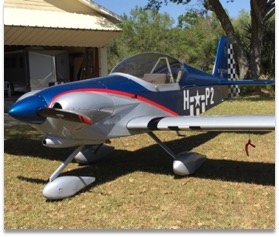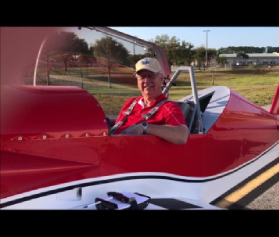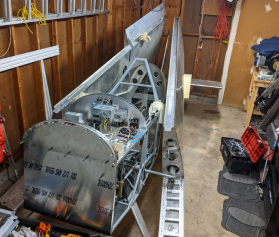We now have 86 production Panther builders across the globe. We love hearing from our builders about their progress and seeing photos of their Panther builds. Here are a few notes sent in from our builders. Keep reading, you won’t want to miss this….
Buddy Henson – Panther SN075 – Green Cove Springs, FL
Buddy is a repeat offender. His first Panther was a Lycoming 0-320 powered LS Tail Dragger – SN017, that he sold to Janson Kinsley. He is now building another 0-320, but this time it is the Tri-Gear version. Here is a photo of his progress. The wings are complete as well. 90% done and 90% to go. Great work Buddy!

Jim Coonan – Panther SN061 – Ransom, IL
Jim and his grandson Alex spend their spare time working in the garage working on their projects. Jim is building a Panther Tri-Gear. Alex is working on a Super Stohl. We stopped by their place last summer on the way back from Airventure. They have a first class workshop and they are both first class gentleman with excellent builder skills and attention to detail. Alex sent me a quick photo of Jim and his daughter Allie working on the fuselage of the Panther.


Sean Sullivan – Panther SN048 – Fort Worth, TX
Got this note today from Sean –
“Hi Guys,
I just wanted to let you know , I received my airworthiness certificate for my Panther today! N485PA is official!
Hopefully my first flight will be later this week if the weather is favorable.
Thanks!
Sean Sullivan”

SEE all of Brian and Sean’s Panther progress on Facebook @panthercitypanthers
Dan Heath – Panther SN020 – Lexington, SC
Dan Heath sent in the photo below of his UL Power 350 engine installed on his Panther LS. He has made excellent progress on his build. Congrats, Dan! Looking great. See updates from Dan Heath HERE.
Bob Rychel, Ed Brennan and Les Boatright – Panther SN083 – Titusville, FL
The three builders in southern Florida sent in the below update on their Panther build. This was a write-up they put in their monthly EAA Chapter newsletter. These guys are making excellent progress on their project.
PANTHER PROGRESS REPORT:
There’s been a fair amount of interest from folks in the chapter and at the airport regarding the Panther kitplane project that Bob, Ed, and myself have been working on recently. So I’ll go ahead and give you a Panther Project report here in the newsletter and save a little time during our next chapter meeting.

Photo: Panther Prototype in flight
First of all, I’d like to apologize to anyone who may have dropped by the hangar to check out the project and may have left not feeling very welcome. Just consider it an unintended consequence of making progress. We certainly do welcome any visitors and interested folks, and we enjoy talking about the project, but in the interest of pushing forward on it quickly, we’ve tried to stay focused on tasks, keep our distractions to a minimum, and so we haven’t stopped for very long to jaw-bone with folks. This workman-like approach has paid off big as we have currently completed nearly all of the major airframe structures! Our pile of parts left to install in the plane is dwindling fast! First, let me take you back in time a few weeks to the start. We took possession of the kit on January 13th (of this year), and the next day (1/14) was our first full day of building. As I write this at the end of February (2/26), only 44 calendar days have passed, and we have logged right at 600 total man-hours since we began the project. We’re keeping a log of our time mostly for fun, but also to see what it really takes to get a small, simple, well-engineered machine like this into the air.
At this point in the project, we have essentially completed ALL of the major structures of the airframe, including empennage, both wings (including fuel tank installation), all control surfaces, and the fuselage (minus the final installation of the forward side skins for better access). The landing gear is attached to the fuselage and most of the control mechanisms are installed in the fuselage. There are still many small details left to do, but this past weekend we fit-checked the wings into the fuselage for the first time, and although they took a little finessing, they generally lined up very nicely. For those who do not know, the Panther is designed with folding wings to permit easy trailering, or to allow for hangaring with another aircraft and thus keep ownership costs low. This is a really nice feature, but it adds a few man-hours and some additional parts to the overall project.

Photo: Panther prototype – only 7 feet wide with wings folded
We already have our engine (a nice used Lyc. O-235), and we should be installing it and fitting the cowling and baffles over the next month, as well as planning out the instrument panel, working on the canopy installation, and final painting many of the major structures. We will also be working through a lot of those little bits & details that any big project has. Don’t let our speedy progress fool you, this IS a big project, and a lot of hard work is involved. However, with most of the structure completed and the fuselage now resting on its gear, it’s starting to feel like we’re reaching that proverbial stage of being 90% done, with 90% left to go!!
Over the past 44 days we’ve had about 4 “guest” builders drop by and spend a few hours working with us to experience the thrill of airplane building. Besides that, we have had countless chapter members and airport regulars drop by to see the machine and check out our progress. Most of them seem to be impressed with the quality of the kit, and the speed of our progress. It’s always nice to have someone stop by and offer up words of encouragement. And who knows, when they see how our project is turning out, they may decide to become Panther builders themselves!! I should probably mention that Bob, Ed, and myself are not first time builders. We all three have lengthy technical backgrounds, and all have previous building experience with our own personal aircraft projects. We also collectively bring a fairly complete set of aircraft tools with us from our other projects, so there has been little time wasted waiting for some special tool or drill bit to arrive in the mail. In addition, we made several decisions right from the very start about the project to help it move along faster, including our choice to use a simple, straightforward, and well known aircraft engine for the powerplant (Lyc. O-235), our decision to use protruding head rivets to save time dimpling skins and countersinking frames, our decision to purchase pre-built fuel tanks from the factory, our plan to go with a very simple VFR instrument panel and electrical system, and our choice of a simple single-color paint scheme. We have naturally found tasks that each of us are good at, and we’ve divided up portions of the kit in some areas so that we can work tasks in parallel, and at other times we have worked as a team in other areas of the kit.
When Bob, Ed & myself began this effort, we thoroughly discussed things like our expectations for budgets, for timelines, our own personal time available to work on the project, and our personal objectives for building this particular airplane at this particular time (all three are slightly different). We also never set out to build an Oshkosh Grand Champion award winner. We just wanted a simple, robust, reliable, economical little airframe that we could fly the daylights out of!!
Of course, we haven’t flown yet, but speaking for myself, the project has fully exceeded my expectations in terms of budget and timeline, at least up to this point. Doing a project like this as a team really helps to move the thing along! In fact, the old adage “Many hands make light work” comes to mind. On more than one occasion, one of us has gotten stumped on a particular task or set of instructions, or couldn’t find a specific call-out in the drawing or manual, and we were able to talk it through together and quickly resolve the issue and move on. Also, learning new building skills and techniques from each other is another unexpected consequence of working on a project like this as a team. I knew from our upfront research that this was essentially a fast-build kit, and given our experience I knew we would make good progress, but I honestly did not think we would be this far along this fast!! I’m very happy that we are, and I can’t wait to get back out to the hangar and make some more progress!
Say, do you think ol’ Smilin’ Jack would like to fly around in a flaming red Panther Sportplane?
Yep, me too!

Well, it sure looks like we’ve succeeded in accomplishing the 5 F’s for the month of February . . .
Friends, Flying, Fun, Fabricating (our flying machines), & Food.”
So from our shop to all of the builders out there – great job on building and congratulations to you all for keeping at it! Keep eating those elephants, one bite at a time.
– Team SPA



